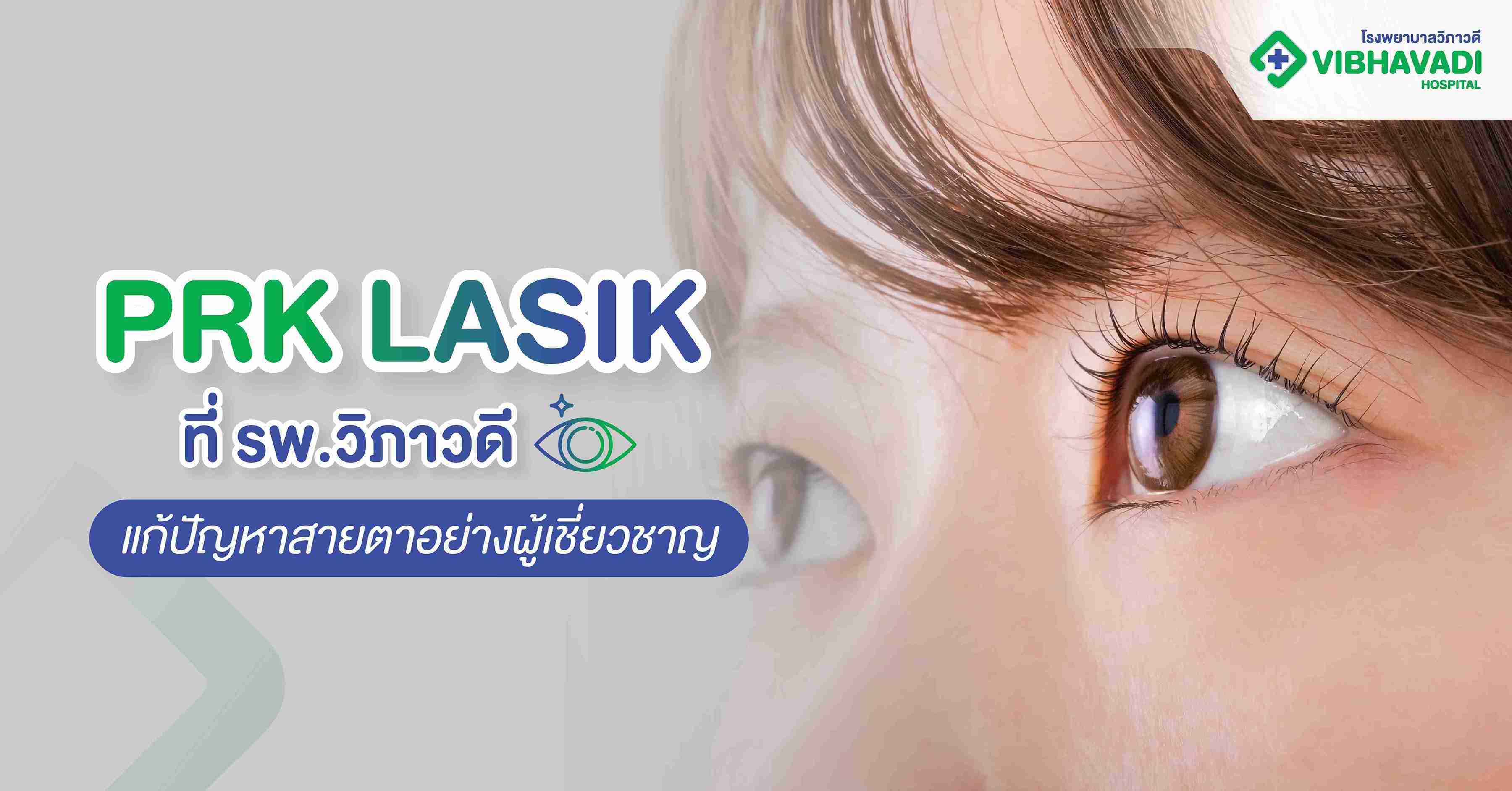PRK LASIK

PRK LASIK Eye Surgery: A Precise Vision Correction Option at Vibhavadi Hospital
Photorefractive Keratectomy (PRK) is one of the earliest forms of laser eye surgery developed to correct refractive errors such as nearsightedness, farsightedness, and astigmatism. Although LASIK has become more commonly known, PRK remains a highly effective and safe option — especially for individuals with thin corneas or other eye conditions that make them unsuitable for LASIK. At Vibhavadi Hospital, our team of experienced ophthalmologists offers advanced PRK treatment using state-of-the-art technology and a patient-centered approach.
What is PRK LASIK?
PRK (Photorefractive Keratectomy) is a type of refractive eye surgery that uses an excimer laser to reshape the cornea, allowing light entering the eye to be properly focused onto the retina for clearer vision. Unlike traditional LASIK, PRK does not involve the creation of a corneal flap. Instead, the outer layer of the cornea (epithelium) is gently removed, and the underlying corneal tissue is reshaped using a laser.
PRK is particularly well-suited for patients with thinner corneas, irregular corneal surfaces, or those who are involved in contact sports or high-risk professions where eye trauma is more likely.
Who is a Suitable Candidate for PRK?
PRK may be a better choice than LASIK for certain individuals. Ideal candidates typically include:
-
People with thin corneas that may not support a corneal flap
-
Individuals with dry eyes or a history of dry eye symptoms
-
Patients involved in activities or jobs with a risk of eye impact (e.g., martial arts, military, law enforcement)
-
Those who do not qualify for LASIK due to corneal irregularities or other contraindications
Before proceeding with PRK, patients must undergo a comprehensive eye examination at Vibhavadi Hospital to determine if they are suitable candidates for the procedure.
How Does PRK Work?
Step 1: Preoperative Evaluation
Before surgery, patients are thoroughly evaluated using advanced diagnostic equipment to measure corneal thickness, refractive error, and eye health. The ophthalmologist will discuss the procedure, expected results, and any potential risks.
Step 2: The Procedure
On the day of surgery, anesthetic eye drops are used to numb the eye. The outermost layer of the cornea (epithelium) is removed, either manually or with an alcohol solution. The excimer laser is then used to reshape the underlying corneal tissue, correcting the patient’s refractive error.
Step 3: Recovery and Healing
Unlike LASIK, PRK requires a longer recovery time since the epithelium needs to regenerate. A soft contact lens is placed on the eye as a bandage to protect it during the healing process. Vision may initially be blurry, but it gradually improves over several days to weeks.
Benefits of PRK LASIK
-
No corneal flap: Eliminates flap-related complications such as dislocation or inflammation.
-
Suitable for thin corneas: Provides an alternative for patients who are not LASIK candidates.
-
Long-term stability: Offers excellent long-term results similar to LASIK.
-
Lower risk of dry eye: May cause fewer dry eye symptoms postoperatively compared to LASIK.
Risks and Side Effects
Like all surgeries, PRK carries some risks. Common side effects include:
-
Temporary discomfort or irritation during healing
-
Blurry vision during the first few days
-
Light sensitivity or glare
-
Risk of corneal haze (especially without proper postoperative care)
At Vibhavadi Hospital, these risks are minimized through the use of cutting-edge technology, personalized surgical planning, and detailed aftercare instructions.
Recovery Timeline After PRK
PRK recovery is typically longer than LASIK. Here's a general timeline:
-
Day 1–3: Discomfort, tearing, and light sensitivity are common. Rest and avoid screen time.
-
Day 4–7: Bandage contact lens is removed. Vision starts to improve but may still be blurry.
-
Week 2–4: Gradual visual stabilization. Resume most daily activities.
-
Month 3–6: Final vision outcomes achieved. Regular follow-ups ensure optimal healing.
Patients must follow all postoperative care instructions and attend scheduled checkups at Vibhavadi Hospital.
PRK vs. LASIK: What’s the Difference?
| Feature | PRK | LASIK |
|---|---|---|
| Corneal flap | No flap | Flap created |
| Recovery time | Longer (days to weeks) | Faster (1–3 days) |
| Pain/discomfort | Mild to moderate after surgery | Minimal |
| Suitable for thin corneas | Yes | Often not recommended |
| Risk of flap complications | None | Possible |
Patients at Vibhavadi Hospital can discuss both options with their ophthalmologist to determine which procedure aligns best with their eye health, lifestyle, and visual needs.
PRK at Vibhavadi Hospital
Vibhavadi Hospital offers PRK eye surgery using the latest laser technologies and internationally recognized clinical protocols. Our approach focuses on patient safety, comfort, and long-term vision improvement. Services include:
-
Preoperative diagnostic screening with topography and corneal thickness measurement
-
Advanced excimer laser technology with customized treatment planning
-
Postoperative follow-ups and medication management
-
Individualized recovery plans to minimize discomfort and promote fast healing
Our experienced ophthalmologists work closely with each patient to ensure the highest standards of care throughout the entire surgical journey.
Preparing for PRK Surgery
Before undergoing PRK, patients should:
-
Stop wearing contact lenses 1–2 weeks prior (depending on lens type)
-
Avoid eye makeup or lotions on the day of surgery
-
Arrange for someone to drive them home after the procedure
-
Plan to take a few days off work for rest and recovery
Our team at Vibhavadi Hospital will provide a detailed checklist to help patients prepare for the procedure and recovery period.
Life After PRK: What to Expect
Most patients experience a significant improvement in vision within a few weeks, and many achieve 20/20 vision or better without the need for glasses or contact lenses. However, it's important to:
-
Use prescribed eye drops regularly to reduce inflammation and support healing
-
Protect the eyes from sunlight and dust by wearing sunglasses outdoors
-
Avoid rubbing the eyes during recovery
-
Attend follow-up appointments as scheduled
With proper care, PRK offers long-lasting vision correction and high patient satisfaction.
Frequently Asked Questions (FAQ)
Is PRK painful?
Most patients experience mild discomfort for the first few days. Eye drops and pain relievers help manage symptoms during recovery.
How long before I can see clearly?
Vision typically improves noticeably within 5–7 days and continues to stabilize over 3–6 months.
Can I drive after PRK?
Driving is not recommended for the first few days. You may resume driving once your vision meets legal driving standards, usually within a week.
Is PRK safe?
Yes, PRK is a safe and FDA-approved procedure when performed by experienced ophthalmologists with proper preoperative screening.
How long do the results last?
For most patients, the results are permanent, although natural age-related vision changes may occur later in life.
Related Services at Vibhavadi Hospital
-
Comprehensive Eye Examinations
-
LASIK and FemtoLASIK Surgery
-
Cataract Screening and Surgery
-
Dry Eye Evaluation and Treatment
-
Pediatric Eye Care Services
-
Optical and Vision Correction Consultation
Testimonials
.jpg)




